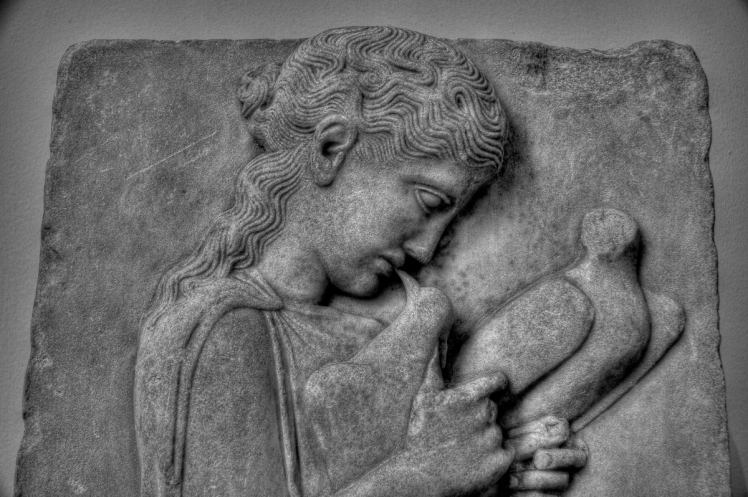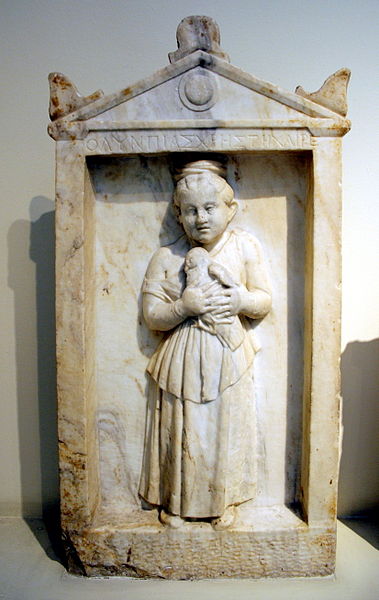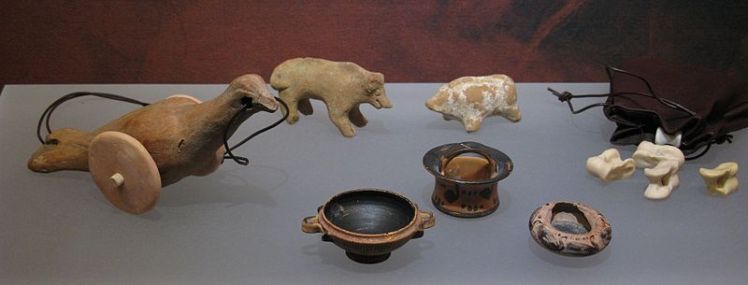
This webpage seeks to paint a picture of girlhood in Ancient Greece, specifically girlhood during the Archaic period, stretching from the seventh century BCE until 480 BCE, and the Classical period which immediately followed it and lasted until 323 BCE. The evidence relayed here is almost exclusively from Greece itself, with some evidence deriving from Italy. I will discuss the birth of daughters, their infancy and girlhood, their role in ritual and religion, and their preparation for marriage.
The Birth of Daughters
The birth of girls was rarely so much as recorded in Ancient Greece, let alone celebrated[1]. While parental love was and always has been a thing, the birth of a daughter caused economic strain as families were expected to a provide dowry (a sum of money, material goods or property) which a girl would bring with her into a marriage so as to attract a husband[2]. A high rate of female infanticide by exposure is likely due to this perception of daughters as burdensome[3].

Infancy and Girlhood
The first six years of girls’ and boys’ life were generally spent in the gyneikeion, or women’s section of the home, under the care of their mother, nurses and female slaves[4].

Siblings played the same gender-neutral games and with the same toys and pets, although juggling, dolls and the game of balancing sticks on one’s hand appear to have been considered especially female[5].
The fourth century BCE female poet Erinna of Teos describes a game played by girls in which one girl crouches pretending to be a tortoise while others encircle her chanting “Torty-tortoise, what are you doing in the middle?”, to which the tortoise replies “I weave wool and Milesian thread”. Both are skills which would have been passed from mother to daughter[6]. The circling girls then ask “What was your son doing when he perished?” to which the tortoise responds “From white horses into the sea he leapt.” With the last word the crouching child leaps up to chase and ‘tag’ a circling girl to replace her as the tortoise[7]. Very much like our modern Duck-Duck-Goose!
Children also played a game similar to modern Jacks, then called Astragaloi [8], as well as Ephidrismos, a game in which a stone is propped up by one team of children and an opposing team must knock it over by throwing small objects at it. Sort of like modern bowling, but wit a twist: Those who miss the stone are ridden in a piggyback style with their eyes covered by their victorious opponent until someone succeeds in knocking over the stone[9].


Ephidrismos sounds pretty intense, and it serves as proof that girls were not discouraged from playing physically demanding games. Spartan girls even received physical education alongside their male counterparts, and participated in the Heraea games at Olympia!
But Ancient Greek childhood was not all fun and games. At the age of seven, citizen boys were sent to school and their female counterparts stayed home to learn how to run a household[10]. Lower class and slave girls, however, had a harsher lot, with the former often working in fields and the latter doing all means of hard physical labour [11].
Girls in Ritual
Young girls in Ancient Greece performed roles in religious ritual probably because they had few other responsibilities and because of the sanctity which was placed on female virginity[12]. The comic Greek playwright Aristophanes’ Lyristrata features a chorus of women who list the ritual duties which they preformed as parthenoi (unmarried, virginal girls), illustrating the centrality of religious ritual to the lives of (especially citizen) girls:
When I was seven years old
I was an arrephoros,
then I was a ‘corn grinder’ at ten
for the Archegetis (Artemis),
and then wearing the saffron-coloured robe
a bear at Brauronia,
and as a beautiful girl I was a basket-bearer
wearing a necklace of dried figs[13].
(Aristophanes, Lystrata 641-47 [412 B.C.E.]; trans. Helene P. Foley)
As this excerpt indicates, the religious duties of elite female virgins were plenty. Whether they be carrying water (Hydrophoi), baskets (Kanepheroi), or Mysteries (vessels the content of which are unknown to this day- Arrepheroi) in religious procession, young girls were very much involved in Ancient Greece’s religious goings-on.
The Transition to Marriage
The youngest a girl could be given away in marriage in Ancient Greece was probably twelve. Yikes. The average ancient Greek girl married at fourteen or fifteen save for Spartan girls who would have married slightly later, between sixteen and eighteen[14]. As previously discussed, girlhood was generally spent in preparation for marriage by teaching girls to manage a household.
A girl’s virgin chastity before marriage was, as illustrated by the role of female virgins in ritual, of the utmost importance[15]. For those who manoeuvred into their mature girlhood without giving speculators cause to believe she had engaged in premarital sex, marriage did not always, or indeed often, herald romance and domestic bliss. Marriage signified the abrupt end of a short childhood and the deportation from one’s familial home to that of their husband[16]. Husbands often lived far from their wife’s family home and were almost always much older. Aristotle proposed that the ideal age for marriage for females was eighteen, whereas for males it was thirty-seven[17]. Again, yikes.

Fun Fact: Bachelor parties originate in Sparta.
To Sum Up
The birth of a daughter, while often met with parental rejoicing, proved an economic blow and was not considered worthy of recording. Female infancy closely resembled male infancy, whereas female childhood diverged starkly from the male, and their relative freedom from responsibility as well as the sanctified female virginity placed girls at the forefront of religious ritual. Finally, marriage marked the sudden death of childhood and was often a traumatic change.
Check out this article about Ancient Greek girlhood, published in 1893!
[1A] Neils & Oakley 2004: 1.
[2] Neils & Oakley 2003: 114
[3] Neils & Oakley 2003: 114
[4] Neils & Oakley 2004: 15
[5] Neils & Oakley 2004: 16-17
[6] Neils & Oakley 2003: 119
[7] Neils & Oakley 2003: 119
[8] Neils & Oakley 2004: 19
[9] Neils & Oakley 2004: 19
[10] Neils & Oakley 2004: 19
[11] Neils & Oakley 2004: 21
[12] Dillon 2002: 37
[13] Dillon 2002: 37
[14] Neils & Oakley 2003: 114
[15] Dillon & James 2015, James: 82
[16] Neils & Oakley 2003: 122
[17] Neils & Oakley 2004: 23
References
All photos are taken from Wikimedia Common.
Dillon, M. (2002). Girls and Women in Classical Greek Religion. New York, NY: Routledge.
Dillion, S. & James, S.L. (2015). A Companion to Women in the Ancient World. Malden, MA: Wiley Blackwell.
Fantham, E. et al. (1994). Women in the Classical World. New York, NY: Oxford University Press.
Neils, J. & Oakley, J.H. (2003). Coming of Age in Ancient Greece. New Haven, CT: Yale University Press.
Neils, J. & Oakley, J.H. (2004). Striving for Excellence: Ancient Greek Childhood and the Olympic Spirit. New York, NY: Alexander S. Onassis Public Benefit Foundation.
I find it so interesting that the birth of girls wasn’t even recorded most of the time! Especially given our contemporary understanding of birth certificates and similar documentary as essential pieces of our identity. It makes me wonder when and under what circumstances this practice eventually changed.
LikeLiked by 1 person